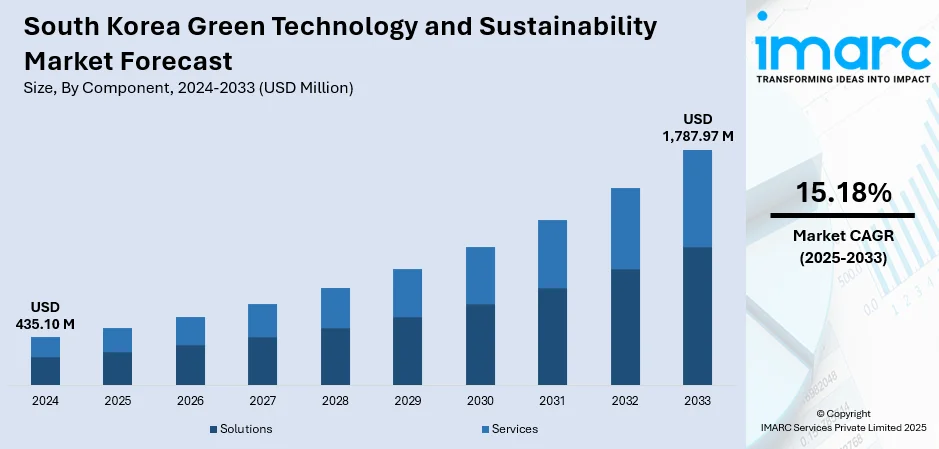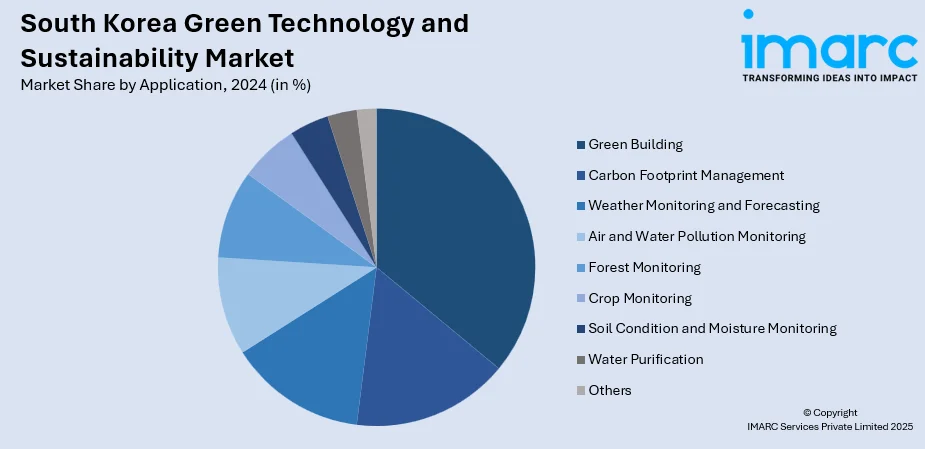
South Korea Green Technology and Sustainability Market Size, Share, Trends and Forecast by Component, Technology, Application, and Region, 2025-2033
South Korea Green Technology and Sustainability Market Overview:
The South Korea green technology and sustainability market size reached USD 435.10 Million in 2024. Looking forward, the market is expected to reach USD 1,787.97 Million by 2033, exhibiting a growth rate (CAGR) of 15.18% during 2025-2033. The market is expanding rapidly, driven by strong government policies, corporate ESG commitments, and advancements in renewable energy, smart grids, and eco-friendly infrastructure. Growing public awareness and international cooperation further support innovation and adoption. These trends are collectively boosting the South Korea green technology and sustainability market share.
|
Report Attribute
|
Key Statistics
|
|---|---|
|
Base Year
|
2024
|
|
Forecast Years
|
2025-2033
|
|
Historical Years
|
2019-2024
|
| Market Size in 2024 | USD 435.10 Million |
| Market Forecast in 2033 | USD 1,787.97 Million |
| Market Growth Rate 2025-2033 | 15.18% |
South Korea Green Technology and Sustainability Market Trends:
Government Policy Support and Green Financing
South Korea's green technology sector is highly backed by forward-looking government policies and strategic investment programs. The country's "Carbon Neutrality 2050" plan and Green New Deal provide a strong foundation for ambitious emission cuts and clean energy targets. Initiatives like the Korea Emissions Trading Scheme (K-ETS) and green finance tools like green bonds and tax credits draw public and private investments into the green economy. The government is further engaged in establishing a national green taxonomy to ensure uniformity in environmentally sustainable activities. These policy mechanisms accelerate the deployment of green technologies, such as energy storage, electric mobility, and eco-friendly construction, while helping de-risk investments, encouraging widespread adoption, and long-term market stability across the sustainability ecosystem.

To get more information on this market, Request Sample
Renewable Energy Expansion and Smart Grid Development
The rapid expansion of renewable energy infrastructure is a core driver of the South Korea green technology and sustainability market growth. With efforts such as the Renewable Energy 3020 Plan, the government is heavily augmenting solar, wind, and offshore energy capacities. But to effectively utilize these intermittent sources, South Korea is heavily investing in smart grid technology. These consist of advanced metering systems, real-time energy monitoring, demand response programs, and computerized grid control centers. These improvements are pivotal in maintaining stability, efficiency, and flexible power transmission throughout the nation. Synergy of clean energy production and smart grid systems increases energy security and enables decarbonization, providing the building blocks for a low-carbon, resilient future.
Industrial Innovation and Corporate Sustainability Commitments
South Korea’s technological strength and innovation culture are key accelerators of green growth. Industry leaders like LG and Samsung SDI are advancing battery storage solutions that complement renewable energy, while Hyundai and Kia are pushing the frontiers of hydrogen and electric mobility. In construction, zero-energy and green-certified buildings are becoming mainstream, aligning with national energy efficiency targets. Moreover, strong ESG commitments from conglomerates and increasing R&D investments are driving innovation in carbon capture, smart agriculture, and circular economy practices. The collaboration between government, academia, and private sector ensures continuous development and export of green technologies, positioning South Korea as a global leader in sustainable innovation and environmentally responsible industrial transformation.
South Korea Green Technology and Sustainability Market Segmentation:
IMARC Group provides an analysis of the key trends in each segment of the market, along with forecasts at the country and regional levels for 2025-2033. Our report has categorized the market based on component, technology, and application.
Component Insights:
- Solutions
- Services
The report has provided a detailed breakup and analysis of the market based on the component. This includes solutions and services.
Technology Insights:
- Internet-of-Things
- Cloud Computing
- Artificial Intelligence and Analytics
- Digital Twin
- Cybersecurity
- Blockchain
A detailed breakup and analysis of the market based on technology have also been provided in the report. This includes internet-of-things, cloud computing, artificial intelligence and analytics, digital twin, cybersecurity, and blockchain.
Application Insights:

- Green Building
- Carbon Footprint Management
- Weather Monitoring and Forecasting
- Air and Water Pollution Monitoring
- Forest Monitoring
- Crop Monitoring
- Soil Condition and Moisture Monitoring
- Water Purification
- Others
The report has provided a detailed breakup and analysis of the market based on the application. This includes green building, carbon footprint management, weather monitoring and forecasting, air and water pollution monitoring, forest monitoring, crop monitoring, soil condition and moisture monitoring, water purification, and others.
Regional Insights:
- Seoul Capital Area
- Yeongnam (Southeastern Region)
- Honam (Southwestern Region)
- Hoseo (Central Region)
- Others
The report has also provided a comprehensive analysis of all the major regional markets, which include Seoul Capital Area, Yeongnam (Southeastern Region), Honam (Southwestern Region), Hoseo (Central Region), and others.
Competitive Landscape:
The market research report has also provided a comprehensive analysis of the competitive landscape. Competitive analysis such as market structure, key player positioning, top winning strategies, competitive dashboard, and company evaluation quadrant has been covered in the report. Also, detailed profiles of all major companies have been provided.
South Korea Green Technology and Sustainability Market News:
- In March 2024, South Korea unveiled an ambitious green financing initiative worth $313 Billion to address climate change challenges. The plan is designed to reduce greenhouse gas emissions by 40% compared to 2018 levels by the year 2030. This substantial financial pledge highlights the country's intensified efforts toward achieving a low-carbon future.
South Korea Green Technology and Sustainability Market Report Coverage:
| Report Features | Details |
|---|---|
| Base Year of the Analysis | 2024 |
| Historical Period | 2019-2024 |
| Forecast Period | 2025-2033 |
| Units | Million USD |
| Scope of the Report |
Exploration of Historical Trends and Market Outlook, Industry Catalysts and Challenges, Segment-Wise Historical and Future Market Assessment:
|
| Components Covered | Solution, Services |
| Technologies Covered | Internet-of-Things, Cloud Computing, Artificial Intelligence and Analytics, Digital Twin, Cybersecurity, Blockchain |
| Applications Covered | Green Building, Carbon Footprint Management, Weather Monitoring and Forecasting, Air and Water Pollution Monitoring, Forest Monitoring, Crop Monitoring, Soil Condition and Moisture Monitoring, Water Purification, Others |
| Regions Covered | Seoul Capital Area, Yeongnam (Southeastern Region), Honam (Southwestern Region), Hoseo (Central Region), Others |
| Customization Scope | 10% Free Customization |
| Post-Sale Analyst Support | 10-12 Weeks |
| Delivery Format | PDF and Excel through Email (We can also provide the editable version of the report in PPT/Word format on special request) |
Key Questions Answered in This Report:
- How has the South Korea green technology and sustainability market performed so far and how will it perform in the coming years?
- What is the breakup of the South Korea green technology and sustainability market on the basis of component?
- What is the breakup of the South Korea green technology and sustainability market on the basis of technology?
- What is the breakup of the South Korea green technology and sustainability market on the basis of application?
- What is the breakup of the South Korea green technology and sustainability market on the basis of region?
- What are the various stages in the value chain of the South Korea green technology and sustainability market?
- What are the key driving factors and challenges in the South Korea green technology and sustainability market?
- What is the structure of the South Korea green technology and sustainability market and who are the key players?
- What is the degree of competition in the South Korea green technology and sustainability market?
Key Benefits for Stakeholders:
- IMARC’s industry report offers a comprehensive quantitative analysis of various market segments, historical and current market trends, market forecasts, and dynamics of the South Korea green technology and sustainability market from 2019-2033.
- The research report provides the latest information on the market drivers, challenges, and opportunities in the South Korea green technology and sustainability market.
- Porter's five forces analysis assist stakeholders in assessing the impact of new entrants, competitive rivalry, supplier power, buyer power, and the threat of substitution. It helps stakeholders to analyze the level of competition within the South Korea green technology and sustainability industry and its attractiveness.
- Competitive landscape allows stakeholders to understand their competitive environment and provides an insight into the current positions of key players in the market.
Need more help?
- Speak to our experienced analysts for insights on the current market scenarios.
- Include additional segments and countries to customize the report as per your requirement.
- Gain an unparalleled competitive advantage in your domain by understanding how to utilize the report and positively impacting your operations and revenue.
- For further assistance, please connect with our analysts.
 Request Customization
Request Customization
 Speak to an Analyst
Speak to an Analyst
 Request Brochure
Request Brochure
 Inquire Before Buying
Inquire Before Buying




.webp)




.webp)












